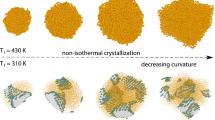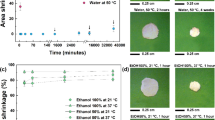Abstract
Elastin (E) coacervation was studied close to isoelectric pH (pI = 4.7 ± 0.5), and this thermally activated self-assembly leading to phase separation involved the following three distinguishable temperatures: onset of interpolymer interaction at Tos, coacervation at Tc, and mesophase separation at Tms. Such behavior was absent in elastin solutions made at other pHs. The pH-dependent particle size histogram revealed bimodal distribution between pH 2 to 4 and 5.5 to 6.2, whereas the region pH = pI ± 0.5, a coacervate-rich domain with trimodal size distribution. The coacervation temperature TC decreased from 38 to 33 °C with increase in solution ionic strength (0–40 mM, NaCl) implying the importance of hydrophobic forces that governed the molecular self-assembly. The thermoreversibility of the turbidity profile implied that the elastin complexes did not fully dissociate into their monomeric state upon temperature reversal. Two observations were made here: (i) the hysteresis loop formed by the heating-cooling cycle had an area that decreased with ionic strength of the solution and (ii) the remnant aggregated E content increased with solution ionic strength. The present study highlights some of the key issues related to the reversibility of self-assembled soft matter systems which remains somewhat poorly explored until now.












Similar content being viewed by others
References
De Jong HB, Kruyt HR (eds) (1949) Colloid science, 2. Elsevier, London, pp 232–238
De Jong HB, Bonner J (1935) Phosphatide auto-complex coacervates as ionic systems and their relation to the protoplasmic membrane. Protoplasma 24(1):198–218
Dubin P, Stewart RJ (2018) Complex coacervation. Soft Matter 14:329–330
Lytle TK, Sing CE (2018) Tuning chain interaction entropy in complex coacervation using polymer stiffness, architecture, and salt valency. Mol Syst Des Eng 3:183–196
Rawat K, Bohidar HB (2014) Coacervation in biopolymers. J Phys Chem Biophys 4(6):1
Cooper CL, Dubin PL, Kayitmazer AB, Turksen S (2005) Polyelectrolyte–protein complexes. Curr Opin Colloid Interface Sci 10:52–78
Pathak J, Priyadarshini E, Rawat K, Bohidar HB (2017) Complex coacervation in charge complementary biopolymers: electrostatic versus surface patch binding. Adv Colloid Interf Sci 250:40–53
Elhassan MS, Oguntoyinbo SI, Taylor J, Taylor JR (2018) Formation and properties of viscoelastic masses made from kafirin by a process of simple coacervation from solution in glacial acetic acid using water. Food Chem 239:333–342
Danielsen S, Delaney K, Fredrickson G (2018) Small ion effects on self-coacervation phenomena in block polyampholytes. Bull Am Phys Soc
Rodriguez AMB, Binks BP, Sekine T (2018) Emulsion stabilisation by complexes of oppositely charged synthetic polyelectrolytes. Soft Matter 14(2):239–254
Li Y, Dubin PL, Havel HA, Edwards SL, Dautzenberg H (1995) Complex formation between polyelectrolyte and oppositely charged mixed micelles: soluble complexes vs coacervation. Langmuir 11(7):2486–2492
Kizilay E, Kayitmazer AB, Dubin PL (2011) Complexation and coacervation of polyelectrolytes with oppositely charged colloids. Adv Colloid Interf Sci 167(1–2):24–37
Imeson AP, Watson APR, Mitchell JR, Ledward DA (1978) Protein recovery from blood plasma by precipitation with polyuronates. Int J Food Sci Technol 13(4):329–338
Tolstoguzov VB (1991) Functional properties of food proteins and role of protein-polysaccharide interaction. Food Hydrocoll 4(6):429–468
De Kruif CG, Weinbreck F, de Vries R (2004) Complex coacervation of proteins and anionic polysaccharides. Curr Opin Colloid Interface Sci 9(5):340–349
Xiao Z, Liu W, Zhu G, Zhou R, Niu Y (2014) A review of the preparation and application of flavour and essential oils microcapsules based on complex coacervation technology. J Sci Food Agric 94(8):1482–1494
Dai R, Wu G, Li W, Zhou Q, Li X, Chen H (2010) Gelatin/carboxymethylcellulose/dioctyl sulfosuccinate sodium microcapsule by complex coacervation and its application for electrophoretic display. Colloids Surf A Physicochem Eng Asp 362(1–3):84–89
Moschakis T, Biliaderis CG (2017) Biopolymer-based coacervates: structures, functionality and applications in food products. Curr Opin Colloid Interface Sci 28:96–109
Tiwari A, Bindal S, Bohidari HB (2008) Kinetics of protein-protein complex coacervation and biphasic release of salbutamol sulfate from coacervate matrix. Biomacromolecules 10(1):184–189
Mohanty B, Bohidar HB (2003) Systematic of alcohol-induced simple coacervation in aqueous gelatin solutions. Biomacromolecules 4(4):1080–1086
Gupta A, Bohidar HB (2005) Kinetics of phase separation in systems exhibiting simple coacervation. Phys Rev E 72(1):011507
Kaibara K, Okazaki T, Bohidar HB, Dubin PL (2000) pH-induced coacervation in complexes of bovine serum albumin and cationic polyelectrolytes. Biomacromolecules 1(1):100–107
Maeda T, Takenouchi M, Yamamoto K, Aoyagi T (2006) Analysis of the formation mechanism for thermoresponsive-type coacervate with functional copolymers consisting of N-isopropylacrylamide and 2-hydroxyisopropylacrylamide. Biomacromolecules 7:2230–2236
Wolf T, Rheinberger T, Wurm FR (2017) Thermoresponsive coacervate formation of random poly (phosphonate) terpolymers. Eur Polym J 95:756–765
Swanson JP, Monteleone LR, Haso F, Costanzo PJ, Liu T, Joy A (2015) A library of thermoresponsive, coacervate-forming biodegradable polyesters. Macromolecules 48:3834–3842
Maeda I, Fukumoto Y, Nose T, Shimohigashi Y, Nezu T, Terada Y, Kodama H, Kaibara K, Okamoto K (2011) Structural requirements essential for elastin coacervation: favorable spatial arrangements of valine ridges on the three-dimensional structure of elastin-derived polypeptide (VPGVG) n. J Pept Sci 17(11):735–743
Betre H, Setton LA, Meyer DE, Chilkoti A (2002) Characterization of a genetically engineered elastin-like polypeptide for cartilaginous tissue repair. Biomacromolecules 3:910–916
Meyer DE, Shin BC, Kong GA, Dewhirst MW, Chilkoti A (2001) Drug targeting using thermally responsive polymers and local hyperthermia. J Control Release 74:213–224
Meyer DE, Chilkoti A (1999) Purification of recombinant proteins by fusion with thermally-responsive polypeptides. Nat Biotechnol 17:1112–1115
Herrero-Vanrell R, Rincon AC, Alonso M, Reboto V, Molina-Martinez IT, Rodriguez-Cabello JC (2005) Self-assembled particles of an elastin-like polymer as vehicles for controlled drug release. J Control Release 102:113–122
Yeo GC, Keeley FW, Weiss AS (2011) Coacervation of tropoelastin. Adv Colloid Interf Sci 167(1–2):94–103
Bohidar HB (2002) Characterization of polyelectrolytes by dynamic light scattering Handbook of Polyelectrolytes, vol II. American Scientific Publishers, California
Baldock C, Oberhauser AF, Ma L, Lammie D, Siegler V, Mithieux SM, Tu Y, Chow JYH, Suleman F, Malfois M, Rogers S (2011) Shape of tropoelastin, the highly extensible protein that controls human tissue elasticity. Proc Natl Acad Sci 108(11):4322–4327
Graham JS, Vomund AN, Phillips CL, Grandbois M (2004) Structural changes in human type I collagen fibrils investigated by force spectroscopy. Exp Cell Res 299(2):335–342
Clarke AW, Arnspang EC, Mithieux SM, Korkmaz E, Braet F, Weiss AS (2006) Tropoelastin massively associates during coacervation to form quantized protein spheres. Biochemistry 45(33):9989–9996
Bellingham CM, Woodhouse KA, Robson P, Rothstein SJ, Keeley FW (2001) Self-aggregation characteristics of recombinantly expressed human elastin polypeptides. Biochim Biophys Acta (BBA) Protein Struct Mol Enzymol 1550(1):6–19
Jamieson AM, Downs CE, Walton AG (1973) Studies of elastin coacervation by quasi-elastic light scattering. Biochim Biophys Acta 271:34–47
Kjaergaard M, Nørholm AB, Hendus–Altenburger R, Pedersen SF, Poulsen FM, Kragelund BB (2010) Temperature-dependent structural changes in intrinsically disordered proteins: formation of α–helices or loss of polyproline II? Protein Sci 19(8):1555–1564
Acknowledgments
PK is thankful to the University Grant Commission, Government of India UGC, for a Senior Research Fellowship. KR is thankful to the Department of Science and Technology, Government of India, for the DST-Inspire Faculty Award. We are thankful to the Advanced Instrumentation Research facility (AIRF) for allowing to access their instrument.
Funding
This study was funded by the Department of Science and Technology (DST), Government of India under the DST-PURSE-II Program.
Author information
Authors and Affiliations
Corresponding authors
Ethics declarations
Conflict of interest
The authors declare that they no conflict of interest.
Additional information
Publisher’s note
Springer Nature remains neutral with regard to jurisdictional claims in published maps and institutional affiliations.
Rights and permissions
About this article
Cite this article
Kaushik, P., Rawat, K. & Bohidar, H.B. Heat-induced coacervation of elastin and its possible thermoreversibility. Colloid Polym Sci 297, 947–956 (2019). https://doi.org/10.1007/s00396-019-04518-1
Received:
Revised:
Accepted:
Published:
Issue Date:
DOI: https://doi.org/10.1007/s00396-019-04518-1




